A new study by the Yale Scientists offers significant proof that supports one of the most popular ideas about the origins of life on Earth — Charles Darwin’s notion of ‘warm little ponds.’ The study suggests that islands jutting up from the world’s oceans gave natural conditions important to early life to flourish.
In his works, Darwin hypothesized that life started when shallow, warm lakes of water permitted essential biomolecules to concentrate and go through polymerization reactions. Numerous researchers accept that if such lakes existed in wealth, or on the off chance that they existed throughout a significant period, it is conceivable that life rose out of a progression of these chemical reactions.
However, there was a problem while applying this hypothesis. The early Earth was a “water world,” covered by deep seas long before the first continents jabbed their way to the surface. In a particular world, Darwin’s shallow, warm lakes essentially didn’t exist.
Scientists may have found the answer.
They developed a theoretical model for the likely topography of Earth’s seafloor during the Archean eon, which lasted from 4,000 million years ago until 2,500 million years ago.
Their model found that a higher amount of internal heating in the Earth’s mantle than what exists today may have ended specific progressing geophysical processes— making a shallowing of ocean basins in individual pieces of the world. In this situation, the analysts stated, volcanic island chains and oceanic plateaus may have remained above sea level for millions of years.
Jun Korenaga of Yale University and Juan Carlos Rosas of the Ensenada Center for Scientific Research and Higher Education in Mexico said, “This is a fascinating finding for solid Earth science as well as prebiotic chemistry. Earth’s internal heating comes from the decay of radioactive elements such as uranium. Because these elements disappear over time, there would have been more of them during the Archeon eon. This would mean there was greater internal heating in the past.”
“My earlier collaboration with Jeffrey Bada, a world expert on prebiotic chemistry at the Scripps Institution of Oceanography, tempted me to look into the influence of this well-known fact of seafloor topography in the past, which had never been explored before. Juan and I were surprised when we first saw our results, but in hindsight, it makes sense.”
“The study will motivate further investigations into the dynamic nature of Earth’s early landscape and its implications for the origin and evolution of life.”
Journal Reference:
- Rosas, J.C., Korenaga, J. Archaean seafloors shallowed with age due to radiogenic heating in the mantle. Nat. Geosci. (, 2021). DOI: 10.1038/s41561-020-00673-1
